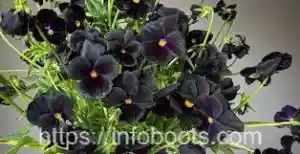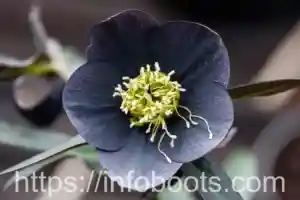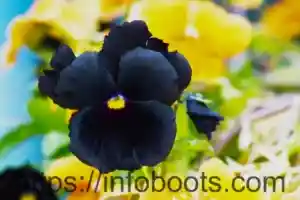Black flowers are rare and captivating plants that add a unique, mysterious touch to any garden or home. Although they are often called “black,” many of these flowers are deep purple, maroon, or dark brown. These dark hues make black flowers stand out in a way no other flowers can. In this guide, we will explore everything you need to know about black flowers, including their care, light, space, and more.
What Is a Black Flower?
It is a plant that produces flowers with dark, almost black petals. However, true black flowers do not exist in nature; most “black” flowers are a deep shade of purple, red, or brown. These flowers get their dark color due to anthocyanin pigments, which also give other flowers their rich, purple hues.
These flowers are prized for their dramatic appearance and can be a striking addition to any garden. Some of these flowers have almost velvety petals, while others may have a shiny surface. They can be found in various plant species, such as roses, lilies, tulips, and orchids.

Top 10 Black Flowers
If you’re interested in adding these flowers to your garden, here are ten beautiful options you can grow or admire:
- Black Velvet Petunia
This petunia is known for its velvety, deep black petals. It creates a dramatic effect in any flower bed or hanging basket. - Black Calla Lily
The Black Calla Lily has elegant, trumpet-shaped blooms. Its dark purple petals are so rich they often appear black. - Black Orchid
The Black Orchid is an exotic and rare flower with dark purple petals that appear almost black under certain lighting. It’s a symbol of mystery and beauty. - Black Hollyhock
This tall flower has dark red to black petals. The Black Hollyhock adds an elegant, Gothic touch to your garden. - Black Dahlia
Black Dahlias are known for their deep, dark petals. They symbolize strength and elegance, making them a favorite in both gardens and floral arrangements. - Bat Flower (Tacca palmata)
The bat flower has unique, black blooms that resemble bat wings. It is often grown as an ornamental plant due to its rare beauty. - Black Baccara Rose
The Black Baccara Rose has petals that are so dark red they appear black. This rose is one of the darkest varieties available. - Black Pansy
Black pansies have dark purple and black petals. Their compact size makes them perfect for small gardens or containers. - Queen of the Night Tulip
These tulips have deep purple petals that look black in low light, adding drama and beauty to any garden. - Black-eyed Susan
While not completely black, the black-eyed Susan features dark centers surrounded by yellow petals, making it stand out in flower beds.

Black Flowers Plant Care
These can thrive with proper care, which includes providing the right soil, watering, light, and nutrients. Each type of black flower may have slightly different needs, but most of them share a few basic care requirements.
Black Flowers Water Requirements
Proper watering is key to keeping black flowers healthy. Most black flowers prefer well-drained soil. Here’s how to water them:
- Frequency: Water the plants once a week, or when the top layer of soil feels dry to the touch. In hot weather, you may need to water them more often.
- Amount: Make sure to water the plants deeply so the roots get enough moisture. However, avoid waterlogging, as this can lead to root rot.
- Drainage: Ensure your plants are growing in soil that drains well. Standing water around the roots can harm the plants.
How Much Light Does a Black Flowers Need?
Most of these flowers need plenty of sunlight to thrive, although some varieties can tolerate partial shade. Here’s a breakdown of light requirements:
- Full Sun: Many flowers, such as Black Velvet Petunia and Black Hollyhock, prefer full sun. These plants need at least 6 hours of direct sunlight each day to grow strong and produce vibrant blooms.
- Partial Shade: Some flowers, like the black calla lily, can tolerate partial shade, especially in warmer climates. Providing shade during the hottest part of the day helps protect these flowers from burning.
How Much Space Does Black Flowers Need?
The space requirements for black flowers vary depending on their size. Here’s a general guide:
- Small Flowers (e.g., Black Pansy, Black Velvet Petunia): These flowers only need about 6 to 12 inches of space between each plant to grow properly.
- Larger Flowers (e.g., Black Dahlia, Black Hollyhock): Larger plants need more room. These flowers should be spaced about 18 to 24 inches apart to allow for proper air circulation and growth.
Plant Nutrients and Water Requirements
To help your flowers grow strong and healthy, it’s important to provide the right nutrients. Here’s what you need to know about feeding and watering black flowers:
- Soil: Flowers thrive in well-drained, fertile soil. Adding compost to the soil can improve its quality and provide essential nutrients.
- Fertilizing: Feed your plants with a balanced fertilizer every 2 to 3 weeks during the growing season. Avoid over-fertilizing, as this can cause the plants to become leggy and weak.
- Watering: Flowers require regular watering, but make sure the soil doesn’t stay too soggy. If the soil is too wet, the roots may rot.
| Nutrient | Function |
|---|---|
| Nitrogen | Helps in leafy growth |
| Phosphorus | Promotes strong roots and flowers |
| Potassium | Strengthens the plant and blooms |
| Magnesium | Helps with photosynthesis |
| Calcium | Strengthens plant cell walls |
| Sulfur | Helps in protein formation |
Plant Pruning and Maintenance
Pruning is important for maintaining healthy flowers and encouraging new growth. Here are some simple tips for plant care:
- Deadheading: Remove dead or faded flowers from the plant to encourage new blooms. This also keeps the plant looking tidy.
- Trimming: Trim back any leggy or overgrown stems. This helps keep the plant compact and prevents it from becoming too unruly.
- Supporting Tall Plants: Plants like the Black Dahlia and Black Hollyhock may require support, such as stakes or cages, to keep them from falling over in the wind.
Diseases and Pests
Like any other flowers, black flowers can be affected by pests and diseases. It’s essential to keep an eye on your plants to catch problems early.
- Common Pests: Aphids, spider mites, and slugs are some of the most common pests that affect black flowers. You can remove these pests by hand or use insecticidal soap.
- Diseases: Black flowers can develop fungal infections like powdery mildew, especially in humid conditions. To prevent disease, make sure the plants have good air circulation and avoid overhead watering.
Black Flowers Care Table
Here’s a detailed table summarizing the care requirements:
| Care Factor | Requirement |
|---|---|
| Watering Frequency | Water once a week or when the soil is dry. |
| Light | Full sun (6+ hours) or partial shade (depends on variety) |
| Soil Type | Well-drained, fertile soil |
| Fertilizer | Balanced fertilizer every 2-3 weeks |
| Space | 6-12 inches for small flowers, 18-24 inches for large flowers |
| Pruning | Remove dead flowers, trim leggy stems, and stake tall plants. |
| Pests/Diseases | Watch for aphids, slugs, and fungal diseases like powdery mildew. |
Conclusion
Black flowers are beautiful and unusual additions to any garden or home. Their dark, mysterious colors make them stand out and add a touch of elegance. With the right care, these flowers can thrive and grow into healthy, vibrant plants.
Whether you choose to grow Black Velvet Petunias, Black Calla Lilies, or other varieties, make sure you meet their needs for sunlight, space, and water. Keep an eye on pests and diseases, and prune regularly to keep your flowers looking their best. With these tips, you can enjoy the beauty of black flowers in your garden for years to come.

